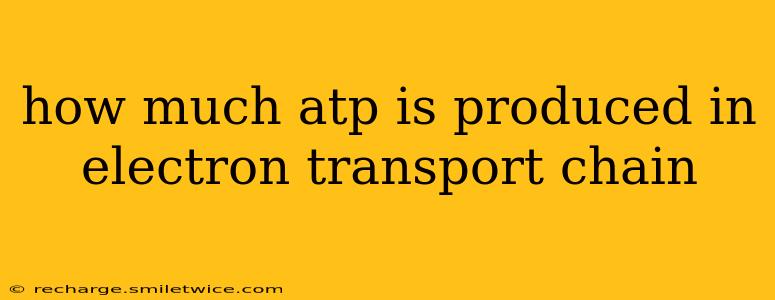The electron transport chain (ETC), the final stage of cellular respiration, is where the majority of ATP (adenosine triphosphate), the cell's energy currency, is produced. While the exact number varies slightly depending on the cell type and efficiency, the generally accepted yield is between 28 and 34 ATP molecules per glucose molecule. This substantial energy harvest makes the ETC crucial for life's processes.
Let's break down why this number isn't a fixed 32, and explore some related questions.
How Many ATP Molecules are Produced in Oxidative Phosphorylation?
It's important to clarify that the electron transport chain is directly involved in oxidative phosphorylation, the process that generates most of the ATP. The ETC itself doesn't directly produce ATP; instead, it creates a proton gradient across the inner mitochondrial membrane. This gradient is then harnessed by ATP synthase, an enzyme that uses the energy of the proton flow to phosphorylate ADP (adenosine diphosphate) into ATP.
The number of ATP molecules produced is dependent on several factors, leading to the range of 28-34:
- The proton motive force: The efficiency of the proton gradient in driving ATP synthesis can vary slightly depending on cellular conditions.
- The P/O ratio: This refers to the number of ATP molecules produced per oxygen atom consumed. The precise P/O ratio can vary depending on experimental conditions.
- Shuttle systems: The specific shuttle system used to transport NADH from glycolysis into the mitochondria affects the number of ATP produced. The malate-aspartate shuttle is more efficient than the glycerol-3-phosphate shuttle.
What are the Steps Involved in ATP Production in the Electron Transport Chain?
The process can be summarized in these key steps:
- Electron delivery: Electrons from NADH and FADH2, generated earlier in cellular respiration (glycolysis and the Krebs cycle), are passed along a series of protein complexes (Complex I-IV) embedded in the inner mitochondrial membrane.
- Proton pumping: As electrons move down the chain, energy is released, and this energy is used to pump protons (H+) from the mitochondrial matrix across the inner membrane into the intermembrane space. This creates the proton gradient, also known as the proton motive force.
- Chemiosmosis: The protons flow back down their concentration gradient, through ATP synthase, a channel protein that acts like a turbine. This flow drives the rotation of ATP synthase, which catalyzes the phosphorylation of ADP to ATP.
- Oxygen as the final electron acceptor: Oxygen accepts the electrons at the end of the chain, combining with protons to form water. This is crucial because it maintains the electron flow and keeps the entire process going.
Does the Electron Transport Chain Produce More ATP Than Glycolysis and the Krebs Cycle?
Yes, overwhelmingly so. Glycolysis produces a net of 2 ATP molecules, while the Krebs cycle produces 2 ATP molecules directly. The vast majority of ATP generated during cellular respiration is produced by the ETC through oxidative phosphorylation (28-34 ATP).
What Factors Affect ATP Production in the Electron Transport Chain?
Several factors can influence the efficiency of ATP production in the ETC:
- Oxygen availability: Oxygen is essential as the final electron acceptor. Lack of oxygen leads to a halt in the ETC and significantly reduced ATP production.
- Temperature: Extreme temperatures can denature proteins involved in the ETC, reducing its efficiency.
- pH: Changes in pH can affect the activity of enzymes involved in the process.
- Inhibitors and uncouplers: Certain substances can inhibit the ETC or disrupt the proton gradient, reducing ATP production.
Understanding the precise yield of ATP from the electron transport chain is complex, but grasping the underlying principles of oxidative phosphorylation is key to understanding cellular energy production. While the number isn't rigidly fixed at 32, the range of 28-34 provides a reasonable estimate for the significant contribution of the ETC to cellular energy.
